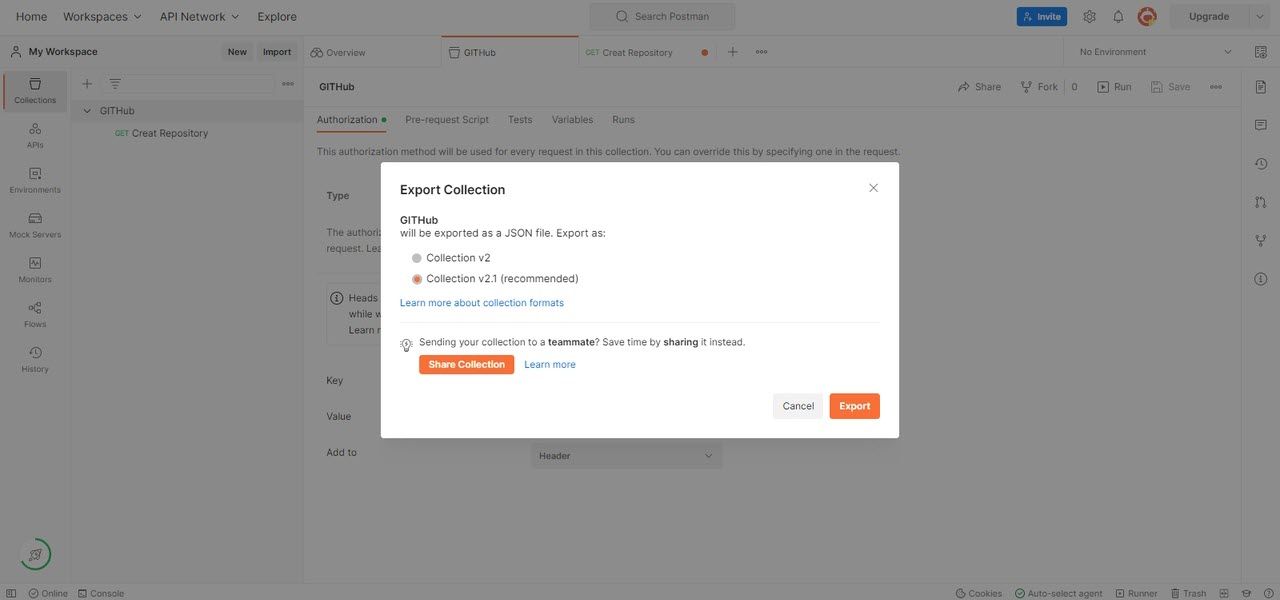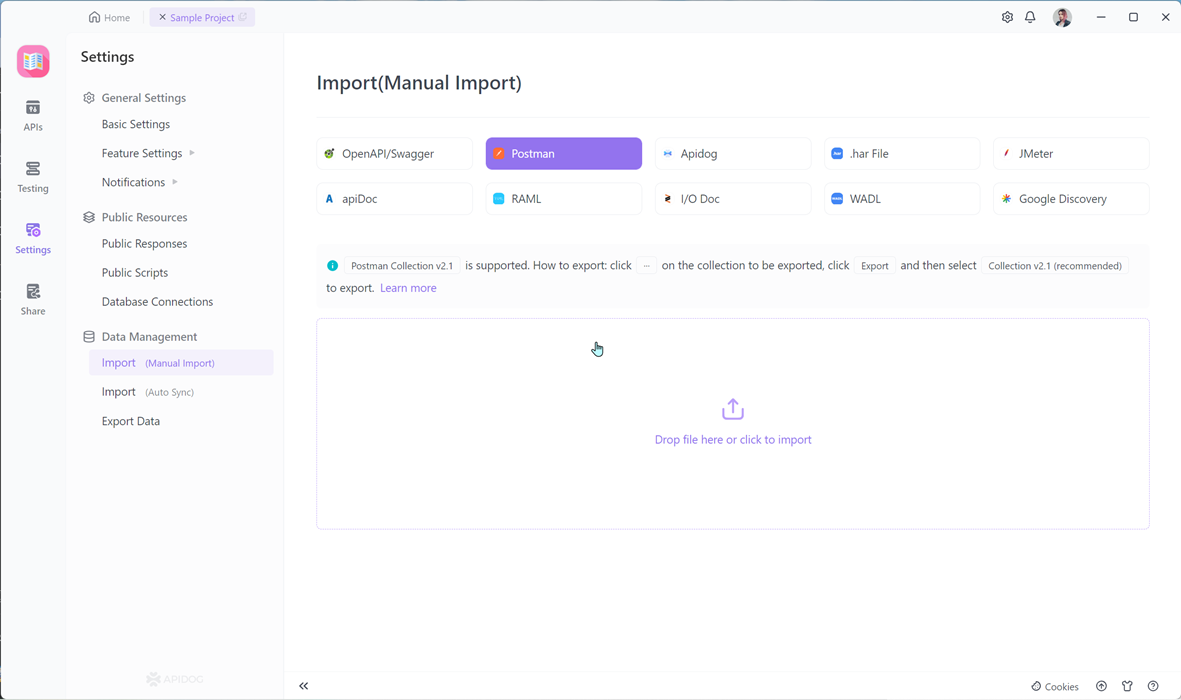If you're an avid user of Postman for API testing, you may have encountered a frustrating issue where you hit the limit for running collections. Once you've run more than 25 times runner in free plan, you'll be prompted with a message that says "You have exhausted all the runs. To keep running collections, create an account..." This can be a real hindrance to your workflow, especially if you're working on a large project or team.
Fortunately, there are some solutions that you can use to bypass this limitation and keep running your collections smoothly. In this article, we'll explore some of the best methods for overcoming Postman's collection limit and continuing your API testing without any interruptions.
What is a Postman Collection?
A Postman Collection is a group of requests that can be saved and shared with other users. It allows developers to organize, document, and automate their API testing workflows in a single location. In a Postman Collection, you can include requests, tests, and scripts, making sharing API workflows with team members or collaborators easy.

Postman Collection Limitation
The Postman Collection Run limit refers to the number of times a collection can be executed within a given time period. This limit is imposed to prevent abuse of the Postman API and to ensure that the service remains stable for all users.
To better align with the value Postman’s test automation offers for professional testers and quality engineers, Postman made the following changes effective February 15, 2023, for free customers, and effective March 15, 2023, for new paid plan customers. Existing paid plan customers saw these limits effective upon plan renewal after March 15, 2023 (except Enterprise users, who have unlimited runs per month):
Local Collection Runner: Runs will be available with Free and Basic plans at 25 runs per month, Professional plan at 250 runs per month, and Enterprise plan at unlimited runs per month.
How to Fix Postman Collection Runner Restrictions?
Many loyal users are expressing frustration with Postman's recent changes to its pricing plan, specifically in regard to the limit on local runs. Paying customers on the basic plan now has the same number of runs as the free tier, and the limit of 25 on the basic plan is seen as nonsensical by many.
Some are calling for Postman to reconsider the changes, while others are exploring Postman alternative tools like Apidog that offer more flexibility without any restrictions on the number of runs.
Apidog is a powerful testing tool that overcomes the Collection Run limit in Postman. It offers a robust testing framework and automation features, real-time feedback, and comprehensive test reports, as well as easy integration with other testing tools. Apidog enables developers to efficiently create, test, and manage APIs without restrictions, resulting in a more productive development process.
Method 1. Importing Postman into Apidog (Free & Best)
Apidog goes beyond just overcoming the limitations of Postman Collection Runner. It offers a comprehensive feature for enhanced API testing - test scenarios.
As mentioned earlier, test scenarios in Apidog are equivalent to Postman collection runners. You can easily organize and manage API requests, and create, share, and generate detailed reports for better analysis and collaboration.
One of the standout features of Apidog is its robust support for Continuous Integration (CI). With Apidog's flexible CI integrations, developers can easily incorporate automated API testing into their build pipelines.
This enables efficient regression testing throughout the development lifecycle, from commit to deployment. By surfacing bugs early through CI, Apidog helps teams maintain quality and stability even as they iterate rapidly.

Next, you will get a handy guide to quickly importing Postman collections into Apidog.
Step 1: Export Your Postman Collection
First, you can use your Postman collections in a different program by exporting them. By selecting the desired collection and clicking the "Export" option, you can seamlessly transfer the collection from Postman to Apidog, as shown in the screenshot below.

In this step, it is recommended that you select the second option, Collection v2.1. This is because if you export the file in the Collection v2.1 format, all queries, directories, and details about your environment will be included in the file.

In addition, the exported file will include any request-specific information you may have, such as logs, query parameters, and content. Selecting the Collection v2.1 format, clicking Export, and saving the file to your computer are all necessary steps.
Step 2: Import Collection in Apidog
Log in to Apidog, import the exported file as shown in the picture, select "Settings" from the left menu, and then select "Import".

Select "Postman" and upload a file from downloads. Upload output data source from Postman. Click the “Confirm” button. After importing successfully, you can view APIs in the left-sidebar in APIs. And if you want to test these requests, just utilize the feature of "Test Scenario."

Step 3. Create Test Scenarios:
Click the "+" button on the "Testing" page in the Apidog latest version, and setting up the details of the New Test Scenario, such as the priority, test scenario name, and folder.

Step 4: Import from API Csaes
Develop comprehensive test cases detailing exact steps, inputs, expected outputs, preconditions, and postconditions to execute tests. Validate test cases thoroughly and cover all critical functions and features per test scenario objectives.

Step 5. Run the Test Scenario
Thoroughly review and validate the test scenarios and cases to ensure comprehensive coverage of all critical functionalities and features. Accurately represent the test scenario objectives through the validation of test cases.
Execute the test cases, carefully tracking the results. Document any defects or issues encountered during testing.

With Apidog, you can collaborate, simulate API requests, and troubleshoot efficiently for faster development. These features improve communication, streamline workflows, and ensure reliable and scalable APIs.
By organizing requests into collections, developers can more efficiently test and debug their APIs, as well as easily share and collaborate with others. Additionally, collections can be automated using tools like Postman or Newman, allowing for even greater efficiency in API development and testing.
If you are running into the collection run limit issue in Postman, there are other ways you can fix it:
Method 2. Upgrade to a Postman Paid Plan
To be honest, if you're looking for a cost-effective solution, you can import your Postman collection into Apidog for FREE. However, if you find you're consistently hitting the collection limit, upgrading to a paid plan can increase your limit and access advanced features.

Method 3. Archive Old Collections
If you have a lot of old collections that you are not actively using, consider archiving them to free up space for new collections.
Method 4. Use the Postman API
You can use the Postman API to run collections programmatically, which can be more efficient than running them through Postman.
Method 5. Optimize Your Collections
Make sure that your collections are as efficient as possible by removing any unnecessary requests and ensuring that your tests are streamlined and accurate.
By taking these steps, you can fix the collection run limit issue and continue using Postman to test and debug your APIs.
Conclusion
In conclusion, Postman Collection Runner limitations can be a significant challenge for developers who require unrestricted access to test their APIs. Fortunately, there are several methods to overcome this obstacle. However, one of the most effective and user-friendly options is Apidog.
With Apidog, developers can create, test, and manage APIs efficiently without any restrictions, streamlining their development process. Therefore, we highly recommend using Apidog to ensure the best testing experience and to overcome Postman Collection Runner limitations.



